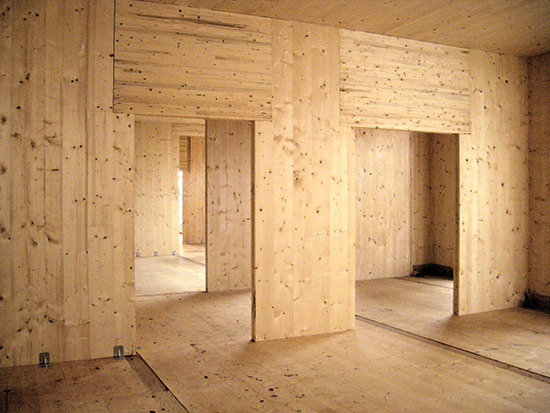Designing for Fire Protection
Exterior Wood-Frame Walls
Wood stud framing is permitted for all load-bearing and non-load-bearing exterior walls in Type V construction. In Type III buildings, exterior walls may be fire-retardant-treated wood (FRTW) in compliance with IBC Section 2303.2 when the exterior wall assembly is required to have a 2-hour rating or less. In Type IV buildings, exterior walls may be of FRTW (the same as in a Type III building) or of cross laminated timber in accordance with Section 602.4.2. The required fire-resistance rating of load-bearing of exterior walls in Type III and IV buildings is 2 hours in accordance with Table 601. For non-load bearing exterior walls, the required fire-resistance rating is based on fire separation distance and occupancy group, in accordance with Table 602. In Types I and II construction, FRTW is permitted to be used in nonbearing exterior walls where fire resistance-rated construction is not required. FRTW can be used to bracing weather resistant cladding systems or to attach window and door units to the elements of the structural frame.
Interior Wood-Frame Walls and Partitions
In Types I and II construction, interior partitions dividing single tenant offices or retail and not creating corridors serving 30 or more occupants are permitted to be FRTW, 1-hour fire-resistance-rated construction, or wood panels or similar light construction up to 6 feet in height. In Types III and V construction, interior building elements may be wood. In Type IV construction, however, interior walls and partitions must be 1-hour fire-resistance-rated construction or solid wood construction formed by at least two layers of 1-inch matched boards or 4-inch-thick laminated construction (such as CLT).
Roofs and Rooftop Structures
In Type I and II construction, FRTW framing in roofs is permitted when certain conditions are met. FRTW framing can be used in roof elements in Type II construction of any height and in Type I construction of any height provided the vertical distance between the roof and floor below is at least 20 feet. Heavy timber is allowed in any construction type except Type 1A, where a 1-hour or less fire-resistance rating is required.
Separations and Openings
Exterior openings are generally required to be protected with a rated opening protective assembly when the exterior wall is within relatively close proximity (< 30 feet) of the property line. IBC Tables 601 and 602 determine when the exterior walls are required to be rated and Table 705.8 defines the allowable percentages of protected and unprotected openings in those walls.
Unlimited amounts of unprotected openings are permitted by Table 705.8 provided the exterior walls are 30 feet or more from the property line, or 10 feet or more in a Type IIB or VB building. No unprotected openings are permitted in the exterior wall within 5 feet of the property line for nonsprinklered buildings and no openings are permitted if the wall is closer than 3 feet from the property line.
Bay and oriel windows must conform to the type of construction required for the building; however, FRTW is permitted for Type I, II, III and IV buildings not more than three stories above grade plane. Untreated wood may be used in Type V buildings (IBC Section 705.2.4).
Interior wood doors are required to be protected when the wall assembly they are in requires a fire-resistance rating, such as interior exit stairways or fire partitions serving as corridor walls. The minimum required fire door assembly rating is given in IBC Table 716.1(2) and ranges from 20 minutes to 3 hours based on the type of assembly in which it is installed and the required fire-resistance rating of the wall assembly.










